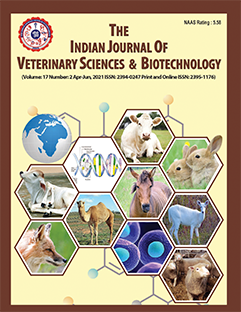Trends in the Occurrence of Parvoviral Enteritis in Local Canine Population: A Trohoc Study
DOI:
https://doi.org/10.48165/ijvsbt.21.6.31Keywords:
Canine parvo virus-2, Haemorrhagic diarrhoea, Host factors, Retrospective studyAbstract
Parvoviral enteritis (PVE) in dogs causes haemorrhagic diarrhoea, vomiting and leukopenia resulting in sepsis and death. Though the disease is more commonly reported in young dogs, adult dogs of pure breeds are also vulnerable to PVE, due to the breakdown of immunity. Hence, a retrospective study on the occurrence of PVE in dog population of local region of Namakkal, Tamil Nadu (India) over two years was conducted. The incidence rate in the year 2023 and 2024 was high in dogs with the age group of 0-3 months (39.7% and 37.3%), males (77.9 and 70.7 %) and non-descript breeds (62.3 and 64.7 %). A high incidence was observed in summer (32.5 %) in the year 2023 and south-west monsoon (59.2 %) in 2024. Between the two years, a significant difference (p<0.01) was observed in the incidence rate with respect to the age, sex and season. Hence, due to increasing incidence of PVE every year, there is a need for region-wise surveillance of PVE to understand the susceptibility pattern of various pure and indigenous breeds of dogs in local regions.
Downloads
References
Abdalla, M.Z.M., Alshiekh Awooda, M.F., El Ayis, A.A., & Mursal, W.I. (2023). Prevalence of canine parvovirus infection in Khartoum State, Sudan. Asian Journal of Research in Animal and Veterinary Sciences, 6(2), 144-152.
Alzuheir, I.H., Fayyad, A.F., Abu Helal, B.Y., Atalla, H.A., & Jalboush, N.H. (2024). Detection of canine parvovirus type 2c (CPV-2c) in Palestine. Journal of Infection in Developing Countries, 18(5), 809-816.
Archana, S., Gupta, D.K., & Kumar, B. (2010). Epidemiology of canine parvovirus infection. Indian Journal of Veterinary Research, 18, 42-44.
Behera, M., Panda, S.K., Sahoo, P.K., Acharya, A.P., Patra, R.C., Das, S., & Pati, S. (2015). Epidemiological study of canine parvovirus infection in and around Bhubaneswar, Odisha, India. Veterinary World, 8(1), 33-37.
Cenk, E.R., & Mahmut, O.K. (2015). Levels of cardiac biomarkers and coagulation profiles in dogs with parvoviral enteritis. Kafkas Universitesi Veteriner Fakultesi Dergisi, 21(3), 383-388.
Chetan, G.E., Singh, M., Chander, V., Akhilesh, Singh, D., Rajesh, J.B., Prasad, H., & De, U.K. (2021). Occurrence of canine parvovirus-2 and canine adenovirus-1 infections in dogs: A hospital-based study. Indian Journal of Animal Research, 55(2), 217-221.
Decaro, N., & Buonavoglia, C. (2012). Canine parvovirus - A review of epidemiological and diagnostic aspects, with emphasis on type 2c. Veterinary Microbiology, 155(1), 1-12.
Decaro, N., Desario, C., Campolo, M., Elia, G., Martella, V., Ricci, D., Lorusso, E., & Buonavoglia, C. (2005). Clinical and virological findings in pups naturally infected by canine parvovirus type 2 Glu-426 mutant. Journal of Veterinary Diagnostic Investigation, 17, 133-138.
Greene, C.E. (2012). Canine viral enteritis. In: Infectious Diseases of the Dog and Cat (4th ed.). St. Louis: Elsevier Saunders.
Houston, D.M., Ribble, C.S., & Head, L.L. (1996). Risk factors associated with parvovirus enteritis in dogs: 283 cases (1982-1991). Journal of the American Veterinary Medical Association, 208, 542-546.
Jayaprasad, A., Singh, B., Jadav, K., Sinha, Y.K., Lade, D., & Singh, S. (2025). Molecular occurrence of CPV-2 infection in HGE affected dogs. Indian Journal of Animal Research, 59(2), 334-336.
Jyothi, V.P., Bhaskaran, M.S., & Gundi, V.A.K.B. (2024). Epidemiology, molecular prevalence and prevention on canine parvovirus in India: A review. Bioinformation, 20(5), 536-546.
Kantere, M., Athanasiou, L.V., Giannakopoulos, A., Skampardonis, V., Sofia, M., Valiakos, G., Athanasakopoulou, Z., Touloudi, A., Chatzopoulos, D.C., Spyrou, V., & Billinis, C. (2021). Risk and environmental factors associated with the presence of canine parvovirus type 2 in diarrheic dogs from Thessaly, Central Greece. Pathogens, 10, 590.
Khare, D.S., Gupta, D.K., Shukla, P.C., Das, G., Tiwari, A., Meena, N.S., & Khare, R. (2019). Prevalence of canine parvovirus infection in dogs in Jabalpur (MP). Journal of Entomology and Zoology Studies, 7(3), 1495-1498.
Mylonakis, M.E., Kalli, I., & Rallis, T.S. (2016). Canine parvoviral enteritis: An update on the clinical diagnosis, treatment, and prevention. Veterinary Medicine, 7, 91-100.
Patel, H.A., Rao, N., Bhanderi, B.B., Saiyad, S., Hadiya, K.K., & Patel, N. (2022). Diagnosis and incidence of canine parvovirus gastroenteritis. International Journal of Current Microbiology and Applied Sciences, 11(10), 222-229.
Qi, S., Zhao, J., Guo, D., & Sun, D. (2020). A mini-review on the epidemiology of canine parvovirus in China. Frontiers in Veterinary Science, 7, 5.
Saravanan, S., Ramprabhu, R., Mohanapriya, T., Chitra, R., & Ponnu Swamy, K.K. (2020). Retrospective study on risk factors and haemato-biochemical alterations associated with canine parvoviral enteritis. Journal of Entomology and Zoology Studies, 8(6), 342-346.
Sayed-Ahmed, M.Z., Elbaz, E., Younis, E., & Khodier, M. (2021). Canine parvovirus infection in dogs: Prevalence and associated risk factors in Egypt. World Veterinary Journal, 10(4), 571-577.
Sherasiya, R.M., Vagh, A.A., Bilwal, A.K., Damor, J.R., Parmar, V.L., Dodiya, P.G., Baria, V.R., & Patel, P.V. (2024). Prevalence of canine parvoviral infection in dogs in and around Junagadh District of Gujarat State. Indian Journal of Veterinary Sciences & Biotechnology, 20(3), 56-60.
Tangolli, A.A., Gowdaiahnadoddi Krishnaiah, C.K., & Appaiah, K.M. (2025). Clinical lesions in parvo virus infected puppies. Indian Journal of Veterinary Sciences & Biotechnology, 21(2), 118-121.
Downloads
Published
Issue
Section
License
Copyright (c) 2025 Indian Journal of Veterinary Sciences and Biotechnology

This work is licensed under a Creative Commons Attribution-NonCommercial-NoDerivatives 4.0 International License.




